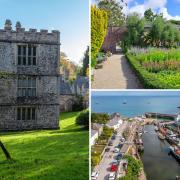Cornwall has long been the spiritual home to visual artists - and now the story of novelists, playwrights and poets is told in a new book
Cornwall has long been the spiritual home to visual artists - and now novelists, playwrights and poets have joined the artistic community...
For centuries, Cornwall’s coastline, creeks and windswept moors and heathland have provided the backdrop for numerous novels, plays and poems. In recent decades the county has gathered significant exposure as a major feature film location and today our unique characters, communities and culture continues to inspire a wide range of television dramas and documentary series, which are now broadcast worldwide.
For those who work in the world of creating words, Cornwall, it seems, is a place that fires the imagination and has the capacity to light the touch paper under the idea of a new novel or help start the strands of script writers storylines.
Every writer needs a place to write in and for many, that place is in Cornwall. While many people set stories in Cornwall, popping down for research before disappearing to London, a new book reveals the writer’s rooms of the many who have stayed or specifically moved here because it provides the one place where they can consistently commit pen to paper, crack on with the next draft or nurse a brand new novel.
The aptly entitled book, A Space to Write is a collection of portrait photography, passages of writers’ work and intimate accounts that share the individual processes and writing spaces of Cornwall’s best-loved wordsmiths.
Photographed by Steve Tanner and compiled by Amanda Harris, A Space to Write, is a celebration of writers past and present, who live by the pen in Cornwall.
As well as capturing the desks, studys or writing sheds of well-known novelists and poets, the book also explores the world of screen and script writers and those creating new work in the form of rap performance and spoken word.
MEGAN CHAPMAN, life guard, youth worker and performance word artist
All my work is delivered to be read out loud. I love the concentrated squash’ – telling a story in three and half minutes, creates a clever flow, using every part of the verse to create impact. The best piece I’ve done was written in fifteen to twenty minutes. I have voice in my head - a judgemental, negative one. I have to turn it off, accept it, then it goes away. So there are two voices in performance. I work out the rhythm and rhyme in my head but they are tweaked on paper. I’m interested in people and emotions, social stuff but not objects. My laptop is useful but I am not sentimental about it. I can work in any chair – I don’t even need a table.’
LIZ KESSLER, author for children and young people
I wanted a sofa bench by the window so I can sit and look out of the window, with a second table so I can work by hand if I need to, as well as at my computer. I wanted to create somewhere where you walk in and it feels creative, where I can come up with stories, relax and be open to ideas… This is the best space I have ever had - quiet, gentle, my heart feels at rest, it has my books, the things I have done, letters from eight-year-old readers,’ says Liz Kessler, best-selling children and young people’s author who writes novels about mermaids, fairies, time travel and superpowers. She also creates books about teenagers coming of age, falling in love and discovering their identity.
To get to my writing space you have to go through two doors and up some stairs, so it is another world, my space, and a place to work. I spent months getting it right and everything has been made specially. I think it has the most stunning view over St Ives Bay.’
PATRICK GALE,novelist
The most important thing in a good writing space is a lack of distraction. A kind of silence, but with music, removed from everyday life. I have a purpose built writing room which my partner built for me on the farm. It was the bull’s shed then a diesel store…There is a desk with a long low window looking over the garden – it is deliberately low so that it can only be seen through when sitting down at the desk.’
Patrick Gale lives, writes and farms near Lands End. His novels include A Perfectly Good Man, The Whole Day Through, the Richard and Judy bestseller Notes From An Exhibition and his latest, the Radio 2 Book Club choice: A Place Called Winter. He chairs the North Cornwall Book Festival, is patron of Penzance LitFest and a director of both Endelienta and the Charles Causley Trust.
JANE DARKE, writer and filmmaker
I’m a cliff-dwelling scavenger who happens to live in Cornwall. My influences are many and varied. I work as a painter, writer and film maker. I like writing on the move, trains are good, distance from home is helpful but not essential. Walking on beaches helps to clear my head but I also work beaches for finds so it’s part of my schedule. I like to sit at my bedroom window which overlooks the bay to read.
All the objects in this room have significance. I write on my mother’s table, that vase she used for the first daffodils each year, that box holds Nick’s (Nick Darke, the playwright) father’s sextant. The drawers are full of our beachcombing collection – sea beans, lobster tags, bird skulls, lighters from all over the world. There are Nick’s fishing diaries and his father’s from the farm, as well as one of each of Nick’s manuscripts.
GRAHAM MITCHELL, screenwriter
I’ve just moved into this house in Falmouth and the sitting room is to become my writing room… it has views over the river! In our last house I worked in a shed a friend made for me. My two favourite places for writing or gathering ideas are cafes and trains. In particular the 18.03 Pullman Carriage, the restaurant car from Paddington to Cornwall,’ says Graham, who writes for the stage and screen; his most recent credits include Silent Witness, Holby City and Waterloo Road.
Cornwall is important to me as a place to live and write because it is where I was born and brought up - my family are from here - it’s where my roots are. When I was young none of this mattered particularly, but as I grow older this sense of place and belonging has become vital to me.'
A Space to Write, which is being published by Kernow Education Arts Partnership as part of The Story Republic creative writing and performance programme, is available from the end of October and can be pre-ordered at thestoryrepublic.co.uk/shop for £19.99
The Story Republic is funded by Arts Council England, The Esmee Fairbairn Foundation and Cornwall Council. Proceeds from A Space to Write, will help to develop writing spaces and literacy programmes in Cornish schools. The touring exhibition of A Space to Write, which has also been awarded funding by FEAST, debuted at The North Cornwall book festival, 23 - 25 October 2015.
A Space to Writewas being launched at Waterstones, Truro on 6 November.



























